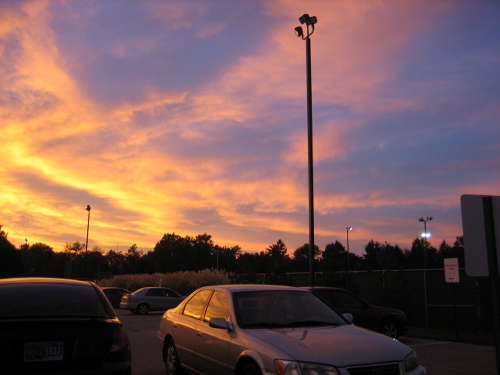 Location Taken: Valparaiso, Indiana
Location Taken: Valparaiso, Indiana
Time Taken: October 2007
It’s rare to see a sunset that’s quite this brilliant. Usually if it’s colorful, it’s not that bright, and vise versa.
I suspect it has something to do with particle size, or perhaps particle location.
Colorful sunsets require lots of particles in the air. They absorb, amplify, and spread the light around to cover the entire sky. That’s why ash from volcanoes triggers colorful sunsets across the world. It also helps to have lots of clouds to provide the purple shadows that so magnificently balance the oranges.
Bright sunsets, on the other hand, require very few particles in the air. Mind you, there’s always going to be particles in the air, if only, well, air molecules. But those particles that spread the color to the entire sky also dilute the brightness. Bright light requires lots of photons traveling in the same direction, so a group of them hit your eye at once. Now, photons like to travel in the same direction (it’s how lasers work), so it’s not too uncommon to see bright sunsets even with all that air in the way. But toss in enough particles and the photons will just keep on running into them and have to go a different way, breaking up the group. Have you ever tried to walk as a group through a crowd? It’s similar to that. You might be able to all get through, but not exactly the way you wanted to, and not in the same arrangement as you started in.
So, more particles equals a colorful sunset, while fewer particles equals a bright one. So how do you get a bright colorful sunset like this one?
I’ve got two hypotheses.
First, particle size. Large particles far apart from each other wouldn’t break up groups of photons as often, but would occasionally intercept an entire group and send it off to a different part of the sky, amplifying the color in the process.
Second, particle location. Only the clouds have the particles. The clouds gain the color-boosting effects of their particles, but elsewhere the photons continue unimpeded. Also, since the photons like going the same direction, they’re likely to bounce as a group if there’s only a few particles in the way, like turning and going a different path if you’re with friends trying to get past a crowd.
It could also be both of these, and of course, it could be something else entirely. I’m only an amateur meteorologist, and I don’t have the equipment required to test these hypotheses. And yes, it’s hypotheses rather than theories. It helps a lot to know your scientific terms.
